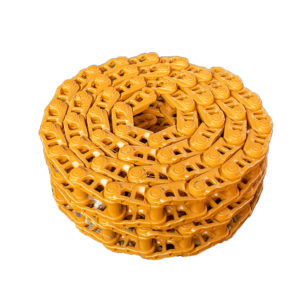Preventing contamination of excavator track links is crucial for maintaining optimal performance, extending the service life of the undercarriage components, and minimizing costly repairs.
Here are some effective strategies to prevent contamination of excavator track links:
- Regular Cleaning: Implement a regular cleaning schedule to remove dirt, mud, debris, and other contaminants from the excavator’s undercarriage, including the track links. Use a pressure washer, steam cleaner, or compressed air to thoroughly clean the tracks and remove accumulated material that can contribute to contamination.
- Track Guards and Seals: Install track guards and seals to protect the track links from debris, moisture, and abrasive materials. These protective measures help minimize the ingress of contaminants and reduce the risk of premature wear, corrosion, and damage to the track links.
- Maintain Proper Track Tension: Ensure that the track tension is within the manufacturer’s recommended specifications. Improper track tension can cause excessive wear on the track links and increase the likelihood of contamination by allowing debris to penetrate between the track links and rollers. Regularly check and adjust the track tension as needed to maintain optimal performance.
- Inspect and Replace Seals: Regularly inspect the seals and gaskets on the track links for signs of wear, damage, or deterioration. Replace worn or damaged seals promptly to maintain effective sealing and prevent contaminants from entering the track link assembly.
- Avoid Operating in Harsh Conditions: Minimize operating the excavator in harsh or abrasive environments whenever possible. Avoid muddy, sandy, or corrosive conditions that can accelerate wear and increase the risk of contamination. China Excavator Track Link suppliers Choose operating routes and work areas that minimize exposure to potential contaminants.
- Proper Lubrication: Ensure that the track links are properly lubricated to reduce friction, wear, and the accumulation of contaminants. Use high-quality lubricants recommended by the manufacturer and follow the recommended lubrication intervals and procedures. Proper lubrication helps maintain smooth operation and prevents premature wear and damage to the track links.
- Monitor and Clean Undercarriage Components: Regularly inspect and clean undercarriage components such as idlers, rollers, and sprockets to prevent buildup of debris and contaminants that can transfer to the track links. Remove accumulated material from these components using a brush, scraper, or compressed air to minimize the risk of contamination.
- Implement Track Shoe Protection: Install track shoe protectors or guards to shield the track links from impact, abrasion, and damage caused by rocks, stumps, or other obstacles. Track shoe protection helps preserve the integrity of the track links and reduces the risk of contamination by preventing foreign objects from contacting the track surface.
- Educate Operators: Train operators on proper operating practices and techniques to minimize the risk of contamination. Emphasize the importance of avoiding excessive speed, sharp turns, and aggressive maneuvers that can increase the likelihood of debris entering the track link assembly.
- Regular Inspection and Maintenance: Conduct regular inspections of the track links and undercarriage components to identify signs of contamination, wear, or damage. Address any issues promptly through inspection, cleaning, repair, or replacement to prevent further damage and ensure optimal performance of the excavator.
By implementing these preventive measures and best practices, operators can minimize the risk of contamination of excavator track links, ensuring smooth operation, extended service life, and reduced maintenance costs. Regular inspection, cleaning, lubrication, and adherence to manufacturer recommendations are essential for maintaining the integrity and performance of the undercarriage components.

Comments